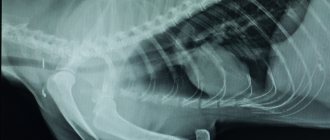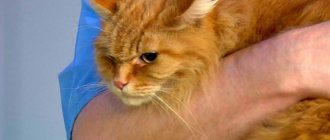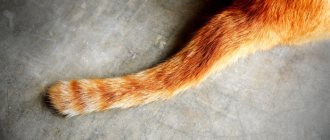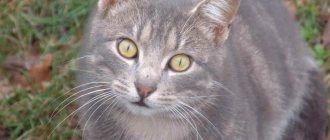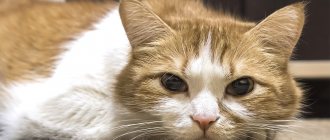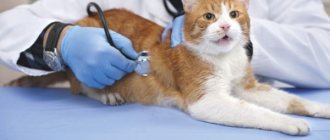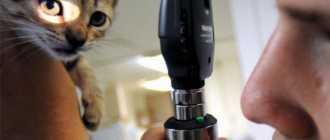Viral peritonitis (FIP) in cats is a fatal viral disease. It is characterized by effusion, granulomas on internal organs and pleurisy. Along with immunodeficiency, panleukopenia and viral leukemia, MPV is the most common cause of death in pets. Although in the last decade advances have been made in the laboratory diagnosis of the disease, despite this, many aspects regarding FIP disease in cats still remain unexplored.
FIP: General information about the disease
FIP disease in cats: what is it? This question arises for those owners whose pet has been diagnosed with this.
Feline infectious peritonitc is translated as infectious or viral peritonitis of representatives of the cat family. The suspected causative agent of this disease is the FECV coronavirus, which is considered relatively safe. Under certain conditions affecting the cat’s body, it begins to mutate. As a result, the virus leads to serious disorders in the animal’s body and its death. Scientists have still not been able to figure out how the disease develops, so diagnosing it in the early stages is almost impossible.
"Important information! According to veterinary statistics, FECV coronavirus was detected in 28% of cats living in groups and in 15% of pets living alone.”
Statistics make it clear that coronavirus in cats cannot be considered a rare phenomenon, but it should be noted that in 2% of cases it still leads to the development of FIP. Diseases of viral etiology are dangerous because infectious agents are very stable and can remain dormant for a long time.
Most often, the FIP virus in cats is diagnosed in kittens or adults under two or after ten years of age. Virological studies prove that the virus often affects animals with weakened immune systems.
Unfortunately, in 98% of cases, viral peritonitis is fatal. It is almost impossible to prevent infection with a deadly virus, since it is not known for certain what factor leads to its mutation.
Prevention
- Do not start infectious and parasitic diseases by carrying out the full course of necessary therapy.
- Do not overfeed your pet, be sure to take measures to prevent obesity.
- It is advisable to limit the cat's free movement along the street. Castrate or neuter.
- The sleeping area should be warm and located in a draft-free room.
- When walking, wear special anti-parasitic collars or drop drops on the withers.
The recovery process can be speeded up a little. To do this, you need to massage regularly every day - 3-5 sessions of 10 minutes each. Massage is carried out only after consultation with a veterinarian, because in some cases there are contraindications for its implementation.
It should be quite intense, but at the same time light, which will not allow the muscles to atrophy. You should try to bend and straighten your limbs, imitate movement in a lying and standing position.
Important!
An exercise that helps with paralysis is an exercise in which the cat, with the help of its owner, tries to walk. To do this, pass a towel under the belly and lift the back of the animal slightly. You need to move your paralyzed paws with your hands, thereby forcing you to move forward.
If your cat loves water, you can use an exercise such as assisted swimming. It is noted that swimming is one of the most effective activities in the fight against paralysis. When there is at least a partial return of sensitivity, you need to scratch its paws and ears so that the animal reflexively tries to do the same. Since it takes a long time to restore nerve endings, physiotherapeutic measures must continue for quite a long time.
Methods of infection with coronavirus
It is generally accepted that animals that live in large groups on the street, at home or in nurseries are at greater risk. Some of them may be carriers of the virus and gradually infect other animals. Other cats can live with the virus for the rest of their lives, while in others the coronavirus mutates and leads to the development of infectious peritonitis. Most often, the disease is diagnosed in kittens aged from four months to six months.
It is very important to promptly determine the source of infection and do everything to prevent the spread of the disease.
An animal can become infected with FIP:
- in utero;
- during mating with an infected animal;
- by contact in contact with feces or saliva of a sick animal.
"Note! Carriers of FIP infection in cats often give birth to sick offspring that die before birth or after birth.”
But it also happens that several kittens survive and become carriers of the disease, infecting other animals. It is recommended to sterilize virus carriers and protect them from contact with relatives.
A relatively safe coronavirus can mutate due to:
- severe stress experienced by the animal;
- pregnancy;
- mating;
- genetic predisposition to viral peritonitis;
- weak immunity.
In the external environment, coronavirus can be destroyed by treating the room with detergents containing chlorine. By treating a room with a sick animal in this way every day, you can minimize the risk of infecting other cats.
The symptoms and treatment of FIP in cats can vary significantly. Everything will depend on the form of the disease, the general condition of the animal, its individual characteristics and immune system.
First aid for stroke in cats
If you notice the symptoms listed above, you must urgently take your pet to the clinic. The cat is placed on its side, on a flat surface, the mouth is opened and the tongue is checked to see if there is any vomit or accumulation of saliva in the mouth.
The main goal of treatment is to reduce inflammation of brain cells and minimize the negative effects of a stroke. During treatment, the animal must be surrounded by care and attention. First, a rehydration solution is administered intravenously to rehydrate the cat's body.
There are no medications that directly treat stroke. For this reason, veterinarians try to find out the exact cause of the stroke so that they can prescribe treatment to eliminate the cause. There are medications prescribed for cats to relieve the symptoms and negative effects of a stroke. Anti-inflammatory medications are prescribed to relieve inflammation of brain tissue. Cats suffering from vomiting are prescribed antiemetics. Symptoms of damage to brain function in the form of disorientation and ataxia are well eliminated by sedatives. Antibiotics are often prescribed to reduce the risk of possible infection. Dietary restrictions are usually not required and the cat can follow a normal diet.
Next, the cat is placed on a soft, warm, dry bedding. The litter needs to be changed from time to time as it becomes moist. Since the cat cannot move on its own, there is a high probability of developing bedsores. This problem can be avoided by regularly turning your cat at regular intervals.
The cat may be in a deplorable state - paralyzed, unable to drink, eat, or defecate on its own. However, in many cases, if help is provided immediately, significant improvements are noticeable within the first three days. If no improvement is observed during this time, the prognosis is unfavorable.
It is extremely important that the cat is under constant supervision during the first days. The pet needs careful care, warmth, and clean bedding. A paralyzed cat needs to be turned from side to side and its paws massaged. If a cat is kept in a cold room or in a draft, there is a high probability of developing pneumonia - one of the common causes of death in animals recovering from a stroke.
The effects of stroke in cats are less noticeable than in humans. Basically, these are violations of motor functions, expressed to one degree or another. There may be problems with memory, vision, and hearing, but the cat quickly adapts, and the owners sometimes don’t even notice that the pet has, for example, become worse at seeing.
If treatment is started promptly, signs of improvement can be seen within the first 72 hours. Treatment of stroke in cats should be accompanied by an appropriate rehabilitation program to help eliminate the consequences. Physical therapy is recommended to achieve improvements in physical health.
The extent of recovery depends on the cat's response to stroke treatment. If stroke symptoms subside within a few days, your cat may make a full recovery from the stroke. In such cases, the recovery period is 2-3 weeks. However, if symptoms do not disappear in the first days, the chances of recovery are very low or completely absent.
Meow to everyone, my good ones! People always face moral and ethical questions when your friend gets sick, and especially when he gets seriously ill and his paws give out.
There are two large groups of reasons why paws become paralyzed. The first group is compression problems and the second is non-compression problems. The largest group is compression causes and the most common cause of paralysis of the limbs is a hereditary predisposition in some breeds. The so-called chondrodysplasia breeds. Chondrodysplasia - (chondrodysplasia; Greek сhondros cartilage + dysplasia) is a group of rare hereditary diseases characterized by skeletal development disorders that are associated with changes in the normal process of ossification of cartilage tissue, its insufficient or excessive formation. These breeds include dachshund, French bulldog, Pekingese, boxer, Maltese, and Scottish fold cats.
Today, due to uncontrolled animal crossing, chondrodysplasia can be found in almost any breed of dog and cat. Due to this predisposition, intervertebral disc disease develops. And if this disease is not noticed in time and treatment is not started in time, it can lead to paralysis of the limbs. Possible injuries to the spinal column due to an accident or a fall from a height. The second group of diseases that lead to paralysis of the limbs are not compression problems. These include spinal cord neoplasms (some neoplasms can also be attributed to compression problems), fibrocartilaginous embolism, myelitis, and syringomyelia. The question arises: if an animal is paralyzed, what to do, how to continue to live with it? I will answer frequently asked questions.
Is my pet suffering?
As a rule, all the previously listed diseases are painless. Pain can only be present in the early stages of the disease. The animal does not experience any moral anxiety. It doesn’t seem to him that it is worse than everyone else and that it is somehow different from others. Such moral experiences are characteristic only of humans.
Will my pet walk?
If the doctor has diagnosed a neurological deficit of degree 6, then you can forget about independent gait. Although there are animals that after 1 year began to walk again. Also, small animals, and especially cats, can develop an unconscious gait, a “spinal gait.” But this takes months. And it is better to do this under the supervision of a rehabilitation doctor. Also, for the full life of paralyzed animals, there are now a lot of devices: special strollers, walkers... They can be ordered via the Internet and they will be delivered anywhere in Russia.
What kind of care should such an animal have?
Before taking responsibility for a disabled animal, you should carefully consider whether you have sufficient time to properly care for such an animal. It is very difficult!
Weight control
Since the animal is lying down and inactive, as a result, fewer calories are consumed. And if you continue to give the same portion as in normal life, the animal will gain weight and become even worse. Plus, you feel sorry for your pets and you give everything that’s delicious and more. This cannot be done! It will be difficult for him, accompanying problems will appear due to excess weight, and it will be even more difficult to develop a “spinal gait”.
Bedsores
If the animal is heavy and inactive, then bedsores will certainly form. To avoid them, the animal must be turned over on the opposite side every 3-4 hours. Provide soft bedding or purchase an anti-bedsore mattress. If bedsores have already appeared, then they need to be treated like open wounds. But under the supervision of a doctor!
Wounds on paws
When an animal walks with the support of a walker, the back of the paws is injured. To avoid this problem, you need to bandage your paws or wrap them with an elastic bandage for walks, or purchase special shoes. It is not a rare problem that animals chew off limbs that they cannot feel. Since this is extra ballast for them. You won't be able to influence this much. If an animal is seen attempting to kill its own paw, a protective collar must be put on it.
How long can they live
However, as long as they would have lived if the animal had not become paralyzed. If provided with proper care, the animal will die in old age. The main thing is to prevent associated problems from developing, such as cystitis, nephritis, bedsores, and soft tissue injury. Living with a disabled animal is difficult. This takes up a lot of personal time. You must approach this step consciously.
First of all, you need to decide whether you have enough strength, time and money to provide your pet with proper support and care. It may take years to get a cat. If the problem cannot be eliminated in a short time, veterinarians usually do not give hope to clients, believing that no one needs long and tedious treatment.
Therefore, if you soberly assessed your capabilities and made a choice in favor, please inform the veterinarian. Depending on the reason why paralysis of the hind legs could occur, he will prescribe a scheme for recovery on an individual basis.
Forms of viral peritonitis
Viral peritonitis is divided into two types, each of which has its own symptoms, course and chances of cure. FIP happens:
- wet. The wet form of peritonitis is an acute type of pathology. During its development, the vascular system is damaged and protein leakage is observed, provoking the accumulation of transudate in the abdominal, pleural or pericardial cavity. This condition develops from two to four months and in 98% of cases ends in death for the animal.
- dry The dry form of FIP in cats is considered chronic and leads to the formation of plaques on internal organs. Diagnosed in animals with strong immunity. The severity of the development of the disease will depend on the organ in which the infectious process develops. The development of the disease lasts up to six months. Dry FIP in cats has a more favorable prognosis as it can be put into remission.
Most often, the wet form of the pathology is diagnosed. In veterinary practice, cases are sometimes recorded when two forms of the disease develop simultaneously.
Misconceptions and facts
Given the lack of knowledge, many misconceptions have formed among pet owners regarding this pathology.
Table 2. Common misconceptions
| Misconception | Refutation |
| FIP and coronavirus are identical diseases | No. The name of all coronavirus strains is FECV. When mutated into the variant that causes infectious peritonitis, it becomes FIPV. The term FIP refers to the name of this disease. |
| FIP is transmitted through contact with an infected animal | The transformation of coronavirus is individual for each animal. Cats do not become infected with FIP, but produce it themselves based on the FECV mutation. |
| Infected animals must be isolated | Infected individuals are not dangerous to other pets. |
| The disease can be determined by antibody titers | This indicator is not decisive in diagnosing the disease. |
| Animals with FIP always have distended peritoneum | Pathology occurs in wet and dry varieties. In the first case, swelling may appear in the abdominal area, as well as in the sternum area. |
| FIP is a hereditary disorder | No, FIP is not a genetic disease. A pet may only have a predisposition to its occurrence due to the state of the immune system. |
| The disease can be prevented by vaccination | No, scientists have not yet achieved success in creating a vaccine. |
| After the death of an infected animal, the premises become dangerous for a new pet | No, the infection is unstable outside the host. According to recent studies, the virus can remain active on dry surfaces for 7 weeks, but it does not take root in another organism. |
Infected individuals are not dangerous to other pets
Symptoms of viral peritonitis
Infectious peritonitis can occur in different ways in an animal. Everything will depend on the intensity of the pathology, the condition of the body and the age of the cat.
The incubation period for the development of the virus in the body can last from a couple of weeks to several months, depending on the number of viral agents and the state of the animal’s immune system.
Clinical signs of FIP in a cat can vary and depend on its form.
Symptoms of exudative viral peritonitis are presented:
- the presence of ascites;
- impaired respiratory function due to accumulation of exudate in the pleural cavity;
- fever;
- lethargy, lack of appetite, development of anorexia;
- renal failure, abnormalities in the functioning of the pancreas and liver;
- enlargement of mesenteric lymph nodes and liver borders;
- nausea and vomiting.
Symptoms of non-exudative viral peritonitis are presented:
- lack of appetite, anorexia;
- damage to the central nervous system, vestibular disorders, seizures, urinary incontinence, behavioral changes;
- eye nystagmus;
- enlargement of mesenteric lymph nodes and liver borders;
- formation of pyogranulomas in the kidneys;
- enlarged colon;
- bowel disorder.
Despite drug therapy, over time the animal begins to weaken, vitality fades, and ultimately death occurs. In rare cases, remission can be achieved. When diagnosing FIP, no veterinarian will guarantee a cat’s recovery, since in most cases, when this pathology is detected, death occurs.
Treatment of the disease
Vascular disease, although relatively rare in itself,30,31 is the fourth most common cause of spinal cord dysfunction in cats.9,27 Ischemic spinal cord infarction occurs due to occlusion of a spinal cord vessel by fibrocartilage material, apparently from an intervertebral disc. . There are many theories described in the literature that explain the route of penetration of intervertebral disc material into the vessels of the spinal cord;
it has been argued that the cause may be mild trauma or migration of disc material into the spinal arteries due to the persistence of common vascular connections between the intervertebral disc and the spinal cord.30,31 Cats with embolic myelopathy due to fibrocartilaginous embolism typically present with acute or hyperacute asymmetrical signs of the lesion. spinal cord, usually progressing in the first 24 hours.30 Palpation of the spinal cord is painless and any segments of the spinal cord can be affected, although areas of thickening are more often affected.30–32
Definitive diagnosis is based on histological confirmation;31 for this reason, antemortem diagnosis is made by excluding other causes of myelopathy. Cerebrospinal fluid analysis may reveal neutrophilic pleocytosis and/or increased total protein. Magnetic resonance imaging is the most sensitive method for detecting ischemic infarcts, characterized by hyperintense signal on T2-weighted images, iso- or slightly hypointense signal on T1-weighted images, and mild contrast enhancement after 3–7 days.9,32
Treatment is supportive, the prognosis is guarded, although it depends on the location of the injury and the severity of clinical signs. Cats that recover begin to improve within 2 to 6 weeks after the onset of symptoms.32
Intervertebral disc disease can develop gradually, starting with constipation, reluctance to jump, low tail position and spinal hyperesthesia
Intervertebral disc diseases are relatively rare in cats, accounting for 0.12% of all neurological diseases.19,33 Cases (as in dogs) of disc protrusion (Hansen type II herniation) and extrusion (Hansen type I herniation) have been described in the literature. although in cats Hansen type I predominates.33 In Hansen type II hernias, the cervical region is most often affected, with the annulus fibrosus protruding into the spinal canal.
34 However, such changes are often discovered incidentally. Disc extrusion, causing neurological dysfunction, is more common in the T10-S1 spinal cord segments (especially the thoracic-lumbar junction (T13-L1) and L4-L6 segments).19,35-37 Reason for higher incidence of disc disease in the lumbar region is unknown, but high mobility of the lumbar and lumbosacral segments may play a large role in the etiology and pathogenesis of spontaneous disc extrusion.19
Intervertebral disc disease is more common in middle-aged and older cats, with a mean age of onset of 7 years.19 Neurological symptoms may develop gradually, starting with altered posture, difficulty getting into/maintaining a defecation position (which can be a secondary cause of constipation), reluctance to jump, low tail position and pain in the spine. These symptoms progress to proprioceptive ataxia and paresis/plegia.
Myelography (with or without CT) helps to localize and assess the degree of spinal cord compression; however, spinal cord swelling/hemorrhage and nerve root compression are better detected by MRI.19,37
Surgical treatment (dorsal decompression/hemilaminectomy) is usually necessary after the onset of neurological signs and has a good prognosis,19,37 although cases of residual urinary and/or fecal incontinence have been reported.19 A recent study of six cats with lumbosacral intervertebral disc disease department, the clinical signs in four cats decreased markedly within 2 weeks, while the remaining two cats continued to have urinary retention and persistent incontinence.36
Spinal cord injury is a significant cause of spinal cord dysfunction in cats.38 The most common injuries in cats include lumbar and thoracic vertebral fractures and dislocations, sacrocaudal luxation/subluxation, and traumatic ischemia and disc extrusion.8,9,23,24 39 In general, spinal cord injury can be caused by an event that directly damages the spinal cord (contusion, concussion, rupture) or a condition affecting surrounding structures (meninges, vertebrae, intervertebral disc) with secondary compression of the spinal cord.
Approximately 20% of cats with spinal cord injuries also have acute intervertebral disc extrusion secondary to injury.23 Although all segments of the spinal cord are susceptible to injury, avulsions, fractures, and dislocations most commonly occur in the cervicothoracic, thoracolumbar, lumbosacral, and sacral regions. tail joints.23,40
Deep pain sensation in the affected extremities is the most important prognostic indicator after spinal trauma.8,24 Absence of deep pain sensation associated with vertebral dislocation/fracture indicates a poor prognosis due to functional spinal cord transection, indicated by complete sensory loss.
8,24 With subluxation in the sacrocaudal region, there is often a crossing of the nerves that form the caudal part of the cauda equina (the roots of the pudendal and sciatic nerves). In such patients, special attention should be paid to the perineal reflex, deep pain sensitivity of the genitals, anal area and tail, as well as the possibility of urinary and fecal incontinence (Fig. 5).8,24,41
RICE. 5. A young cat with a fracture in the lumbosacral region after a traffic accident. Note the hyperextended right hock and flaccid, drooping tail, typical of sciatic and caudal/coccygeal nerve injuries, respectively.
Plain X-rays of the spine are helpful in the initial assessment of the patient. Approximately 20% of patients with thoracolumbar fractures have a second fracture/dislocation in the spine23, therefore any cat with a spinal injury should have x-rays of the entire spine8 as well as plain chest films and abdominal ultrasound.
Modern imaging techniques, such as myelography, CT myelography, or MRI, are needed to evaluate spinal cord compression and examine other injuries not visible on x-rays.8,23,24
When treating a cat with a spinal injury, the primary focus should be on stabilizing the general condition.8 In the case of external trauma, such as from a motor vehicle accident, be sure to assess the airway, breathing, and circulation before neurological examination. It is important that the cat remains immobilized by restraining it on a flat board if feasible.
Fluid therapy is important to maintain spinal cord perfusion. Depending on the severity of hypotension, isotonic crystalloid solutions, hypertonic saline, colloids, or blood products may be administered.8
Opinions regarding the use of steroids in acute spinal cord injury are controversial.42,43 Although they are routinely used in medicine to reduce the secondary effects of ischemia and reperfusion injury,44 the use of steroids in animals with spinal cord injuries can cause side effects, including infectious and gastrointestinal tract infections. intestinal.45,46
If spinal instability is detected, surgical stabilization is necessary.24 The reader is referred to an authoritative source for more information about the surgical treatment of spinal cord injuries.47
Cats with a sacrocaudal avulsion where urinary and defecatory control are normal and pudendal nerve function is preserved (as determined by the presence of a perineal reflex and deep pain sensitivity in the anal and genital area) have a guarded to good prognosis. Overall, the prognosis for spinal cord injuries in cats is guarded, with one study reporting a survival rate of only 60%.23
Lymphosarcoma has historically been considered the most common neoplasm of the feline spinal cord, which was recently reconfirmed by the results of two large studies of cats with different spinal cord diseases.14,27 This tumor is particularly common in young cats infected with feline leukemia virus (FeLV),48–50 but a bimodal pattern has been observed. distribution: 50% of cats under 4 years of age and 25% between 11 and 16 years of age.14
Lymphosarcoma most often affects the thoracic and lumbosacral spine, while the cervical segment is most often affected by gliomas.
Multifocal localization in the spinal cord is highly likely to indicate lymphosarcoma, although multifocal meningiomas sometimes occur.
Lymphosarcoma can progress quickly. Symptoms of spinal cord involvement in multifocal tumors are often accompanied by more general clinical signs such as anorexia, lethargy, and weight loss.13,49,51
Recent work suggests that patient age, disease onset/progression, and location of neurologic symptoms should be considered as significant factors when assessing the likelihood of CNS lymphosarcoma in suspected cases (see Figure 2).14 The definitive diagnosis of lymphosarcoma can be challenging;
Scheme 2
MRI (Fig. 6),14 as well as CSF analysis are the best tests for spinal cord lymphosarcoma; the latter detects neoplastic lymphocytes in approximately 35% of cases (Fig. 7).48
Diagnosis of the disease
FIP is a difficult disease to diagnose. Since the diagnosis of FIP in cats at the initial stage is difficult to make due to the lack of specific symptoms, it is often confused with other pathologies. Wet peritonitis has a similar clinical picture with the bacterial form of the disease, renal ascites, heart failure and toxoplasmosis. And dry with lymphosarcoma and tuberculosis.
Pathology can be diagnosed by:
- blood test for FIP;
- X-ray;
- ultrasound examination of internal organs;
- biopsy of exudate or affected tissue.
The most reliable method is histology of the affected tissue structures. A general blood test has low information content, since it only allows you to determine the presence of antibodies to coronavirus, but it does not make it possible to recognize which strain has infected the animal. A positive result will confirm the presence of viral activity, but will not distinguish peritonitis from enteritis.
Signs of FIP
In veterinary medicine, there are 2 types of FIP: wet and dry peritonitis. The complexity of the course of the disease largely depends not only on the above-mentioned root causes, but also on associated factors (bacterial infections, chronic diseases, method of treatment, and so on).
READ How to stop a cat from scratching furniture
Clinical symptoms of infectious peritonitis in cats:
- depressed state, painful appearance;
- partial loss of appetite;
- photophobia;
- changes in body temperature from high (over 40°C) to low (less than 38°C) and vice versa;
- vomit;
- prolonged diarrhea;
- labored breathing;
- bloating due to large accumulation of fluid in the abdomen;
- gradual or sudden weight loss (protruding ridge, thin paws);
- structural changes in the skin (dryness, yellowness, hair loss, scab formation);
- necrogranulomatous lymphadenitis;
- damage to the central nervous system (symptoms of rheumatism, meningitis, fearfulness, impaired coordination of movements).
Gradually the ward weakens, his vitality fades, and he dies. Unfortunately, no veterinarian can guarantee the recovery of a cat when diagnosed with infectious peritonitis.
FIP treatment
Is there a cure for FIP in cats? It is difficult to answer this question. Long-term remission can be achieved, but in most cases the pathology is fatal. The disease cannot be cured, so veterinarians carry out supportive treatment, in which they prescribe drugs from various groups, including:
- antiviral;
- antibiotics;
- cardiotonics;
- immunostimulants;
- diuretics;
- corticosteroids;
- drugs that prevent potassium leaching;
- vitamins.
In severe cases, a blood transfusion is prescribed, and if fluid accumulates in the peritoneum or chest, it is pumped out. Pumping out the fluid is a temporary measure, since after some time it is collected again. With frequent pumping of exudate, potassium is washed out of the body, which causes irreparable harm to it.
In America, the dry form of viral peritonitis is successfully treated by administering special drugs to the animal. Russian veterinarians have invented the drug “Fosprenil,” which can induce remission and improve the condition of a sick animal.
It is introduced into the abdominal cavity after pumping out the fluid or using an oral or rectal form of administration. Two weeks after administration of the drug, cats experience progressive remission and vital signs stabilize. And in 5% of cases, animals recover completely. However, this drug does not help everyone, so often when a diagnosis of viral peritonitis is made, doctors recommend that the cat’s owner undergo euthanasia.
Diagnosis of paralysis in cats
If a cat's hind legs fail, it is quite difficult to find out the reasons for this. There is a belief that almost all diseases can cause complications and forced limitation of movement.
If a cat does not walk, it can be difficult to distinguish between paralysis of the paws and severe pain that occurs when moving. Perhaps he, experiencing pain when walking, simply refuses to make efforts, since they bring additional discomfort. The causes of severe pain in the back or abdominal area may be the following ailments:
- urolithiasis disease;
- tumor diseases;
- inflammation of the urinary and reproductive system;
- intestinal obstruction.
A distinctive feature of these diseases is that the cat’s paws retain full sensitivity and nerve conduction is not impaired.
If the initial examination is not enough to determine the cause of paw paralysis, then the following diagnostic methods are used:
- determination of neurological reactions;
- X-ray of the spine and affected limbs;
- Ultrasound of the abdominal cavity;
- detailed blood and urine analysis;
- taking smears for bacteriological analysis;
- MRI and CT scans of areas of the body where pathology is suspected to exist (spine, abdominal cavity, brain);
- determining the level of sensitivity of the affected limbs.
Laboratory diagnostics help identify the cause of the disease.
General blood, urine and biochemistry tests monitor the animal’s condition.
For a detailed check, an MRI of the brain and spine is often required.
If infection is suspected, bacteriological analysis is recommended.
To exclude neoplasms and injuries, ultrasound and radiography are usually used. It is worth conducting Doppler sonography to check the filling of blood vessels and access of blood to the extremities.
The limbs are tested for tendon reflexes, tactile and pain sensitivity. This is done in order to assess the extent of the damage.
Diagnosis varies depending on the likely causes of the paralysis. The veterinarian may prescribe a general urine test, which will allow you to assess the health of the animal, and a biochemical blood test.
A urine sample is also taken, and to identify a tumor, an x-ray or ultrasound is prescribed, which allows you to assess the condition of the pelvis, spine and heart.
The doctor will definitely examine the paralyzed paws for sensitivity to touch and pain. He will test for tendon and neurological reflexes.
Important!
All these examinations must be carried out by a doctor. Since it is on the basis of the collected data that treatment will be prescribed.
Preventive actions
Since scientists have not fully studied the mechanism of FIP infection, a vaccine against the disease has not yet been developed. There are drugs that can reduce the risk of coronavirus mutation.
For prevention purposes, veterinarians recommend providing your cat with a balanced diet, proper care, as well as timely vaccination and helminthization.
Fip in cats or what is viral peritonitis
Viral infectious peritonitis in cats
Today, veterinarians are increasingly diagnosing cats with FIP or viral peritonitis. Some even call it feline AIDS. You can read about other cat diseases, for example, paw diseases, here.
There is a lot of speculation around the disease itself, and even more so around how and how to treat it, and whether it can be prevented. And today we will try to figure it all out with you. What is FIP, can an animal be cured of it, and what to do if your pet is diagnosed with this...
What is FIP
As we wrote above, FIP is called viral peritonitis. Its danger lies in the fact that until the very end, owners may not suspect that their pet is already sick. When this becomes obvious, it is too late.
READ Instructions for use of the drug Hepatovet for cats
Today, experts distinguish several types of viral peritonitis: wet and dry. In the first case, the disease is rapid in nature.↑
